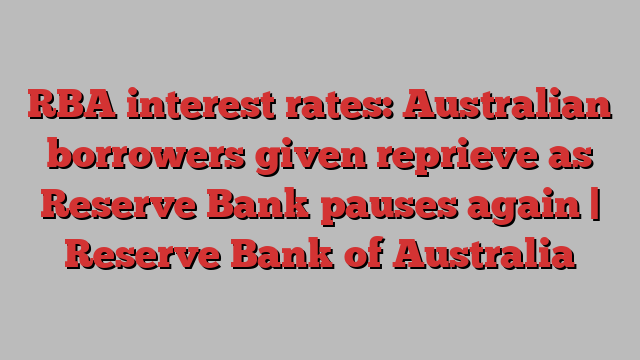
Australia’s borrowers have had another reprieve with the Reserve Bank opting to extend its pause in interest rate rises while it assesses if further increases are needed to curb inflation.
The RBA left its cash rate unchanged at 4.1%, the highest level since 2012. Investors had bet the central bank would stay put for a second consecutive month while a slight majority of economists had forecast a 13th increase in the current cycle.
“Some further tightening of monetary policy may be required to ensure that inflation returns to target in a reasonable timeframe, but that will depend upon the data and the evolving assessment of risks,” Philip Lowe, the RBA governor, said in the accompanying statement.
David Bassanese, chief economist of Betashares, said the RBA should “take heart from the signs of easing in core/service sector inflation globally”.
“Barring an upward inflation surprise, there’s a good chance we’ve seen the last rate increase this cycle,” Bassanese said.
The bank began lifting interest rates from a record low 0.1% in May last year during the federal election campaign. The 400 basis point increase since then is the sharpest tightening of monetary policy in more than three decades – the last time prices were rising as fast.
Australia’s economy has been emitting mixed signals of late. Retail spending in June retreated in real terms, and June quarter inflation figures came in weaker than expected. Employers, though, were continuing to hire staff with little sign yet of a spurt in wages.
While Australia’s economy has been slowing, forecasts by Treasury and the RBA had GDP growth remaining positive this year. Today’s verdict factored in revised forecasts that the central bank will disclose in more detail on Friday.
Australia’s official interest rate remains lower than many similar nations. For instance, the US Federal Reserve last week lifted its key rate to a 22-year high of 5.25% to 5.5%. Canada’s interest rate is also at a two-decade high of 5%, while New Zealand’s main rate sits at 5.5%.
The decision to leave the cash rate unchanged gives the RBA more time to understand whether or not wage increases are gaining momentum. The Australian Bureau of Statistics will disclose June quarter wage price index numbers on 15 August.
The Australian dollar lost more than a quarter of a US cent to trade below 66.7 US cents in the aftermath of the decision. Stocks doubled their gains for the day to be about 0.8% higher. Lower interest rates make the Australian dollar relatively less attractive to hold while company profits are buoyed by reduced debt repayments.
Prior to today, the central bank had said it was aiming to bring annual inflation down to its target range by mid-2025.
after newsletter promotion
On Tuesday, Lowe modified the phrasing, saying: “The central forecast is for CPI inflation to continue to decline, to be around 3.25% by the end of 2024 and to be back within the 2–3% target range in late 2025.”
Economists were wary of reading too much into the change. NAB’s chief economist, Alan Oster, said he expects Friday’s statement will leave the previous forecast unchanged at 3% for June 2025 and predicts inflation will end the year at 2.75%.
Pat Bustamante, a senior Westpac business bank economist, agreed the tweak appeared to be consistent with previous forecasts. He pointed instead to this line that supported the pause, a variation on earlier monthly rate statements: “To date, medium-term inflation expectations have been consistent with the inflation target and it is important that this remains the case.”
Lowe’s statement did not give an estimate for the economy’s growth rate in 2023 but a recession may yet be avoided. In the first three months of the year, it expanded 2.3%.
“The Australian economy is experiencing a period of below-trend growth and this is expected to continue for a while,” Lowe said.
“Household consumption growth is weak, as is dwelling investment,” he said, citing numbers unchanged from the May monetary policy statement. “The central forecast is for GDP growth of around 1.75% over 2024 and a little above 2% over the following year.”
The RBA is also maintaining its previous forecast for the jobless rate to increase by about a full percentage point by the end of 2024, compared to current levels.
“With the economy and employment forecast to grow below trend, the unemployment rate is expected to rise gradually from its current rate of 3.5% to around 4.5% late next year,” Lowe said, adding that “[a]t the aggregate level, wages growth is still consistent with the inflation target, provided that productivity growth picks up”.